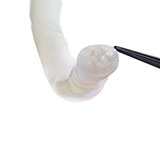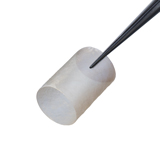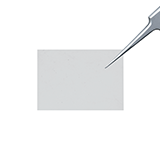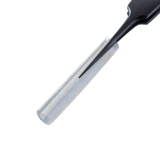mandible resection procedures
Reconstructing and repairing the inferior alveolar nerve (IAN) at the time of mandibular resection is more likely to help patients achieve full functional outcomes, including restoring sensation.1-3 Timing matters, because patients with persistent neurosensory disturbances after IAN damage have consistently reported disturbances to everyday life related to their injuries.3-5
Contemporary management of ablative jaw defects includes not only hard and soft tissue reconstruction, but also restoration of neurosensory function. Connector-Assisted Repair® with Avance Nerve Graft® has demonstrated meaningful recovery rates† of 89% (n=18) when used for IAN repair.6
remember the following:
- According to AAOMS ParCar guidelines, consideration should be given toward neural reconstruction following ablative jaw procedures that result in nerve continuity defects, using interposition autogenous or allogeneic nerve grafting.7
- When a nerve gap is created upon tumor excision, Avance Nerve Graft can be used to bridge a gap up to 7 cm with Connector-Assisted Repair.8
- A Connector-Assisted Repair at the proximal and distal coaptations using a semi-translucent, porcine, small intestine submucosa (SIS) Axoguard Nerve Connector may enable easier coaptation, reduce tension and improve fascicular alignment.8-10
- The construct can be wrapped with an Axoguard Nerve Protector® to provide a physical barrier between the nerve and the surrounding bone, hardware and tissue.
Your skills can help restore nerve function for your patients.
publications
solutions
 Avance Nerve Graft®
Avance Nerve Graft®  Axoguard Nerve Connector®
Axoguard Nerve Connector®  Axoguard HA+ Nerve Protector™
Axoguard HA+ Nerve Protector™  Axoguard Nerve Protector® See sizing and IFU on solution pages
Axoguard Nerve Protector® See sizing and IFU on solution pages more procedures
There’s only a short form between you and our nerve product team who can help you get more information about our nerve repair solutions.
references
†Defined as Medical Research Council Scale of S3/M3 or greater.
- Ducic I, et al. Reconstructive options for inferior alveolar and lingual nerve injuries after dental and oral surgery. Ann Plast Surg. 2019;82(6):653-660.
- Salomon D, et al. Outcomes of immediate allograft reconstruction of long span defects of the inferior alveolar nerve. J Oral Maxillofac Surg. 2016;0278-2391/16/30251-8.
- Leung YY, et al. Trigeminal neurosensory deficit and patient reported outcome measures: the effect on life satisfaction and depression symptoms. PLoS One. 2013;8(8):e72891.
- Cakir M, et al. Effects of inferior alveolar nerve neurosensory deficits on quality of life. Niger J Clin Pract. 2018;21:206-211.
- Patel N, et al. Quality of life following injury to the inferior dental or lingual nerve—a crosssectional mixed-methods study. Oral Surg. 2018;11:(1)9-16.
- Zuniga J, et al. A case-and-control, multisite, positive controlled, prospective study of the safety and effectiveness of immediate inferior alveolar nerve processed nerve allograft reconstruction with ablation of the mandible for benign pathology. J Oral Maxillofac Surg. 2017;75(12):2669-2681.
- American Association of Oral and Maxillofacial Surgeons (AAOMS). Parameters of care: AAOMS clinical practice guidelines for oral and maxillofacial surgery (AAOMS ParCare). 6th ed. 2017:e207.
- Jewell E, et al. Nerve de-tensioning effects of conduits: A quantitative cadaveric analysis comparing conduit-assisted and direct digital nerve repairs. Poster presented at: American Association for Hand Surgery Annual Meeting; January 17-21, 2023; Miami, FL.
- Hanwright PJ, et al. The effects of a porcine extracellular matrix nerve wrap as an adjunct to primary epineurial repair. J Hand Surg Am. 2021;46(9):813.e1-813.e8. doi:10.1016/j.jhsa.2020.11.023
- Ducic I, et al. Refinements of nerve repair with connector-assisted coaptation. Microsurgery. 2017;37(3):256-263. doi:10.1002/micr.30151